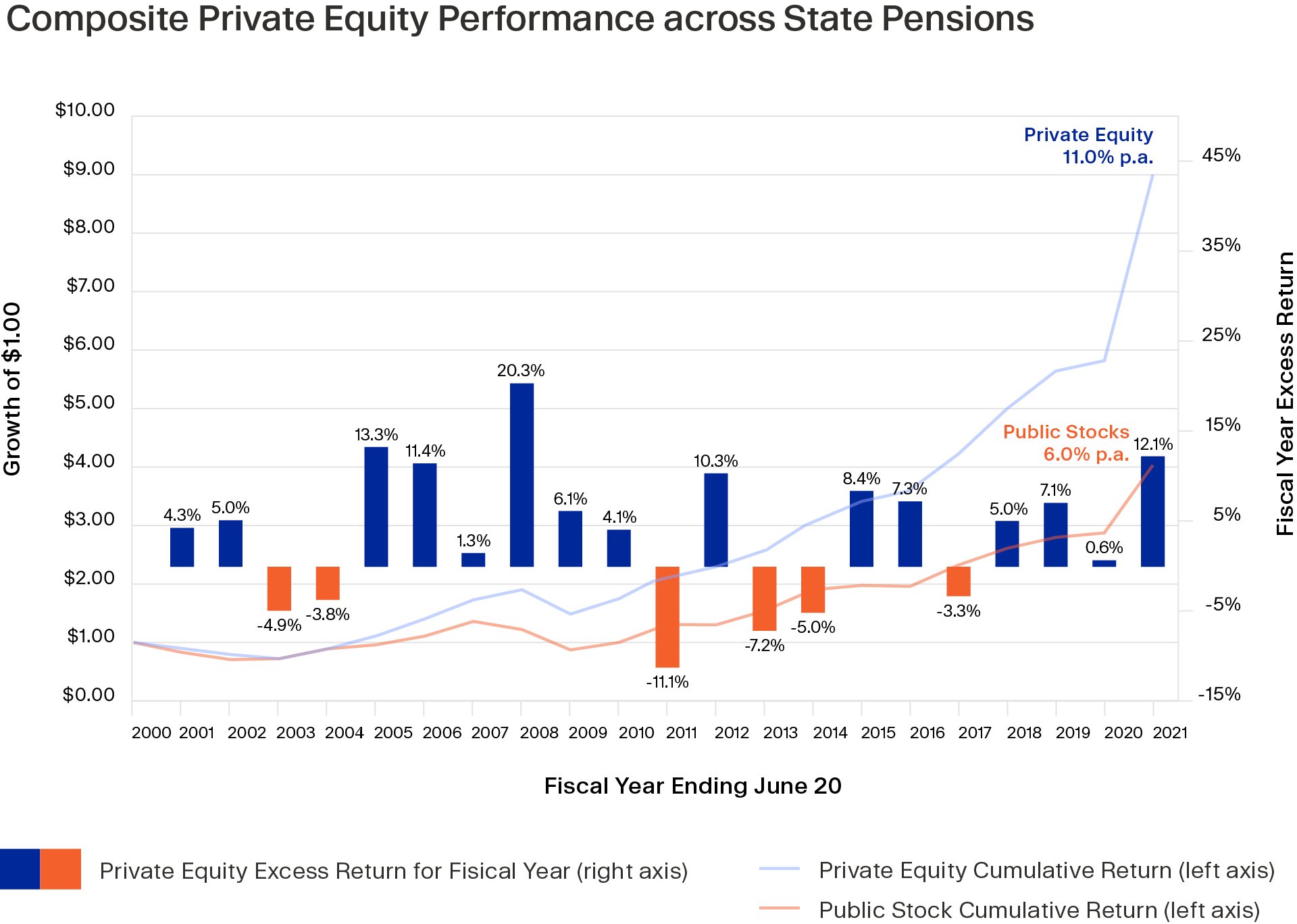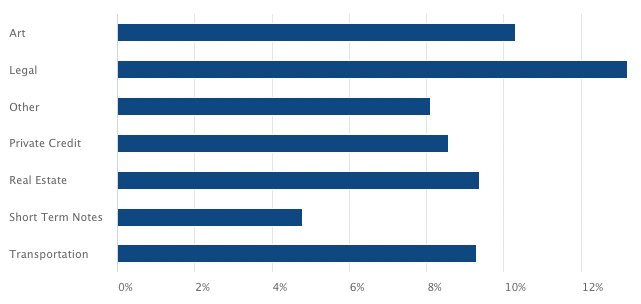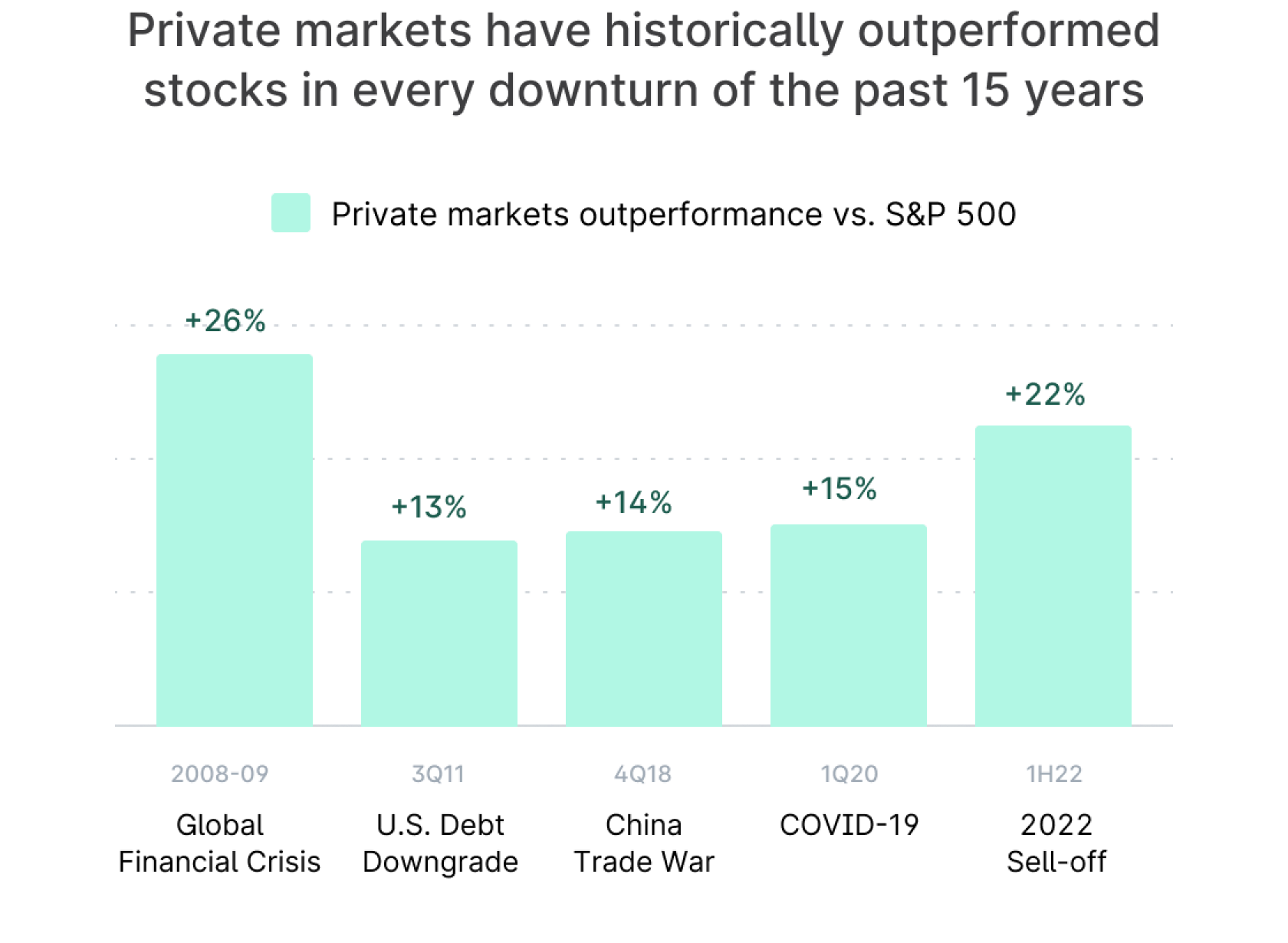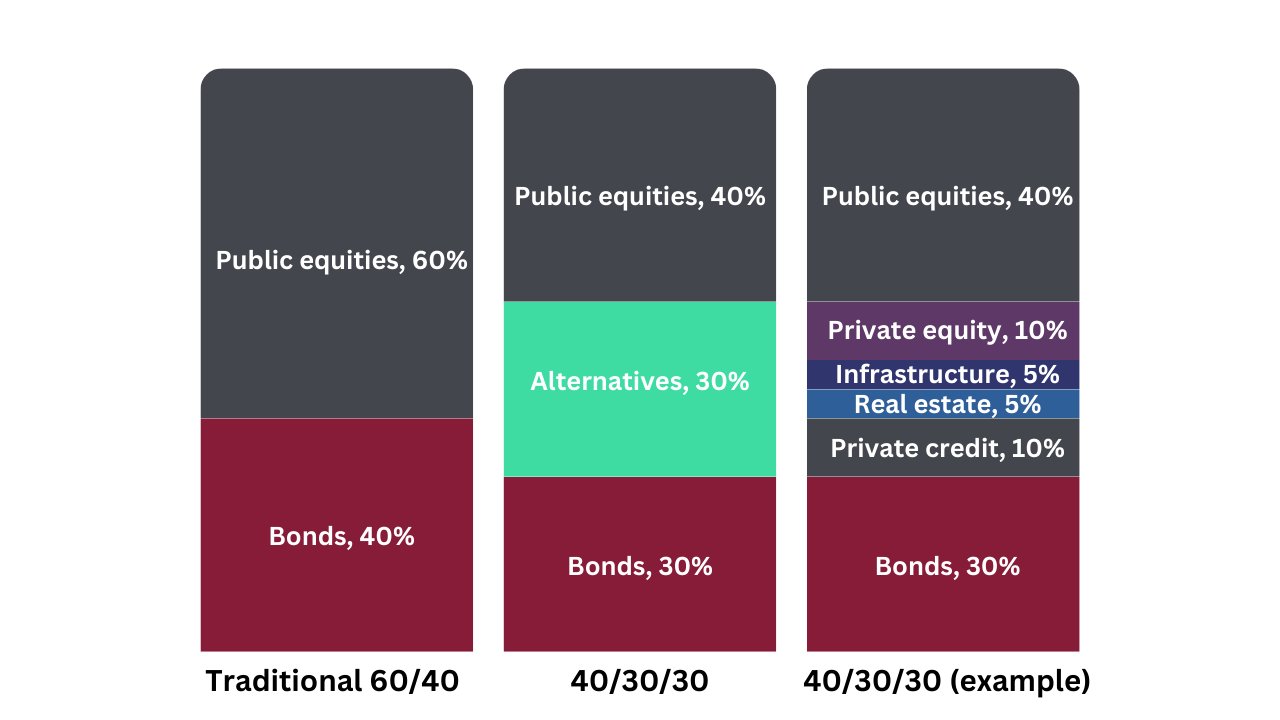Private Market Investing: A Complete Guide

Money has been pouring into private markets.
As of June 30, 2023, there was more than $13.1 trillion invested in private markets. That figure has grown by nearly 20% per year since 2018.
What's causing this explosive growth?
Outperformance — private markets have been outperforming public markets.
Additionally, investing in private market alternatives can increase your portfolio's diversification and lower its volatility and risk. More on that below.
In this article, you'll learn what private market investing is, how it differs from public market investing, why investors are choosing to invest in it, and the risks involved.
Plus, you'll learn exactly how you can start investing in private markets, including private companies, real estate, art, private credit, and more.
What is private market investing?
Any equity- or debt-based investment that is not bought and sold on a public exchange is a “private market” investment.
Private market asset classes include real estate, private equity, venture capital, hedge funds, private debt, art, infrastructure, and more. These assets have long been favorites of institutional investors, private equity offices, and others.
While they used to be hard (or impossible) to access for individual investors, changes in SEC regulations led to a wave of new investment platforms that specialize in varying private markets and alternative assets.
As a result, it's never been easier for individual investors to invest in private markets.
While there are benefits to adding private market investments to a portfolio, it also comes with additional layers of complexity and risk.
Public markets vs private markets
| Public markets | Private markets | |
| Who can access? | Anyone | Primarily accredited investors |
| Example asset classes | Stocks, bonds, ETFs, mutual funds | Real estate, private equity, venture capital, private debt, art |
| Minimum investment size | No minimum | $500 to $10,000+ |
| Regulatory standards | Very high | Medium-high |
| Liquidity | High | Low-medium |
A note on accreditation requirements
Private market investments are primarily available to accredited investors. You can qualify as an accredited investor if:
- You have an annual income of $200,000 individually or $300,000 jointly.
- Your net worth exceeds $1,000,000, excluding your primary residence.
- You are a qualifying financial professional with a Series 7, 65, or 82 license.
Why invest in private markets?
The main benefits of investing in private markets are higher potential returns and diversification outside of public markets.
1. Higher potential returns
In the 21-year period ending in June 2021, private equity investments made by state pension funds outperformed their public equity investments by 4.1% per year:

Source: CAIA.org
Additionally, because of easing regulatory restrictions and the amount of capital available in private equity, many companies are choosing to stay private longer.
This allows them to take more risks and grow faster without constantly feeling the pressure to deliver quarterly results like they would if they were publicly traded.
This outperformance isn't restricted to private equity.
Yieldstreet, a popular alternative investing platform, has seen similar results across the private market assets available on its platform:

Source: Yieldstreet
Because the investments are harder to access, less liquid, more speculative, and overall entail more risk, it would make sense for private markets to outperform public markets.
This is known as “risk premium,” which is a financial theory that states that the riskier an asset is, the higher its expected returns should be.
In the case of private markets, investors should be compensated for accepting lower liquidity and more risk with higher returns.
A note on liquidity
One of the main differences between private and public market investing is liquidity.
Public markets are highly liquid, meaning you can buy and sell your stocks and bonds at pretty much any time. Private markets, on the other hand, have fewer buyers and sellers with which to transact.
However, liquidity can be a double-edged sword.
Since it's so easy to sell public investments, volatility can be significantly higher and can create periods of panic selling.
On the other hand, because there are far fewer buyers — which means panic selling is largely not possible — private market investments are much more likely to go to zero or lose significant value.
2. Diversification
In addition to potentially delivering higher returns, private market investments are not highly correlated with public markets (stocks and bonds).
Here's a graph of the largest quarterly drawdowns of the S&P since 2008 and how private markets performed relative to the stock market:

Source: Yieldstreet
By adding private market investments to your stock-and-bond portfolio, you can reduce your portfolio's volatility and risk.
Spreading your capital across a broader range of investments will lower the effect any one asset class has on your portfolio.
Drawbacks of investing in private markets
As is the case with public investments, there is no guarantee of success.
However, because of a variety of factors, the risks are heightened when investing in private markets.
- Low liquidity: There are no formal secondary marketplaces for many private market asset classes. If you invest, you need to plan on holding for the duration of the investment.
- Long-term investment horizons: Some private assets can have investment time horizons of 10 years or more. Be sure you know potentially how long your money will be locked up before making an investment.
- Limited access: Most private assets are only available to accredited investors.
- High minimums: Even if you're an accredited investor, many platforms have a minimum investment of $10,000 or more.
- Higher risks: Many private market investments have higher failure rates than larger, more established, and more closely regulated companies and asset classes.
How to invest in private markets
1. Determine how much to allocate
For those interested in investing in private markets, most professionals recommend allocating just a portion of your total portfolio to them.
Private market investing should complement your public market investments, not replace them.
For example, KKR suggests investors with a 60/40 stock-bond portfolio may want to transition to a 40/30/30 stock-bond-alternatives portfolio.
Their research suggests this adjustment may improve risk-adjusted returns, increase inflation protection, and lower volatility in a portfolio.

KKR provides the following as an example of how you could allocate the alternatives portion of your portfolio across various private markets:

Disclaimer: This is an example allocation. You should determine the right allocation for yourself based on your age, risk tolerance, and financial goals.
If you're just getting started in private investing, you may want to consider something closer to a 55/35/10 portfolio, in which just 10% of your capital is allocated to alternatives.
2. Decide which investment(s) are right for you
There are many private market investments to choose from, some of which may be more suitable for your portfolio than others.
Below are a few of the most popular private market investments.
Each of these asset classes has its own risk/reward profile as well as benefits and drawbacks. Be sure to carefully research each of them and perform your due diligence before making an investment.
a) Real estate & infrastructure
Since these are real, physical assets, real estate and infrastructure investments are known for their inflation-hedging, as well as their cash flow and steady returns.
However, they often come with high investment minimums.
b) Private equity
Private equity investments are investments in companies that aren't publicly traded.
As noted above, private equity has outperformed public equities in multiple environments.
That said, the asset class is known for its heightened risk of loss of capital. It's also more illiquid and requires more upfront capital than public equities.
c) Private credit
When private companies need to borrow money and don't have access or don't want to use traditional banking channels, they turn to the private credit market.
The average default rates fall between investment-grade and non-investment-grade bonds, but the market's double-digit average returns and short-term durations make it a very attractive investment for income-seeking investors.
d) Art
High-end art has also been used as an inflation hedge and can generate meaningful returns for investors with a keen eye for value.
3. Choose an investment platform
After determining how much money you have to invest and what private markets you're interested in, you'll need to create accounts with different investment platforms.
Similar to how a brokerage account allows you to access public markets, accounts with these platforms give you access to one or more private market investments.
Unlike brokerage accounts, every private market investment platform has its own set of deals and opportunities. Partnering with the right platform(s), even if the fees are higher, will help give you access to the best selection of investments.
A few private market platforms you should know about are:
More on each of these in the next chapter.
Best platforms for private market investing
Yieldstreet: Best for a diversified private market portfolio
Yieldstreet is one of the largest investment platforms for alternative investing.
More than 450,000 members have invested over $3.9 billion on Yieldstreet since 2015.
While most other platforms specialize in a particular asset class, Yieldstreet offers 11 alternative asset classes. These include real estate, art, private equity, private credit, and more.
If you're overwhelmed by all of the alternative investment options available to you, Yieldstreet's Alternative Income Fund may be a good option.
The fund includes 20+ investments spanning a variety of asset classes. It's likely the easiest way to diversify into alternatives.
Plus, the Alternative Income Fund is available for everyone, not just accredited investors.
Hiive: Best for private equity investing in startups
Hiive is a secondary marketplace platform that allows accredited investors to buy shares of private companies.
Some of the most actively traded securities on Hiive are Discord, Databricks, and SpaceX.
Hiive connects sellers (which may be employees, venture capitalists, or angel investors) who want to sell their shares with buyers.
Sellers create listings, which include asking prices and share volume. Buyers can either accept the asking price as listed or place bids and negotiate directly with the sellers.
Percent: Best for private credit
Private credit has been rapidly increasing in popularity, especially among income-seeking investors.
Private credit is known for its high yields (13%+) and short-term durations (usually around 9-10 months). These are the average figures from Percent, a platform that specializes in private credit.
While you can invest in private credit on Yieldstreet, there usually seems to be more deals available on Percent. Plus, Percent's minimum investment is just $500.
Final thoughts
Private markets are attractive for their higher potential returns and diversification.
However, they do come with their own set of challenges and risks.
If you're considering investing in private equity, private credit, real estate, or any other private market asset class, be sure to perform as much due diligence as possible.
Additionally, only allocate as much capital as you're willing to lose. And remember, your money is likely to be tied up for the duration of the investment.
My best advice: go slow.
Any views expressed here do not necessarily reflect the views of Hiive Markets Limited (“Hiive”) or any of its affiliates. Stock Analysis is not a broker-dealer or investment adviser. This communication is for informational purposes only and is not a recommendation, solicitation, or research report relating to any investment strategy, security, or digital asset. All investments involve risk, including the potential loss of principal, and past performance does not guarantee future results. Additionally, there is no guarantee that any statements or opinions provided herein will prove to be correct. Stock Analysis may be compensated for user activity resulting from readers clicking on Hiive affiliate links. Hiive is a registered broker-dealer and a member of FINRA / SIPC. Find Hiive on BrokerCheck.






